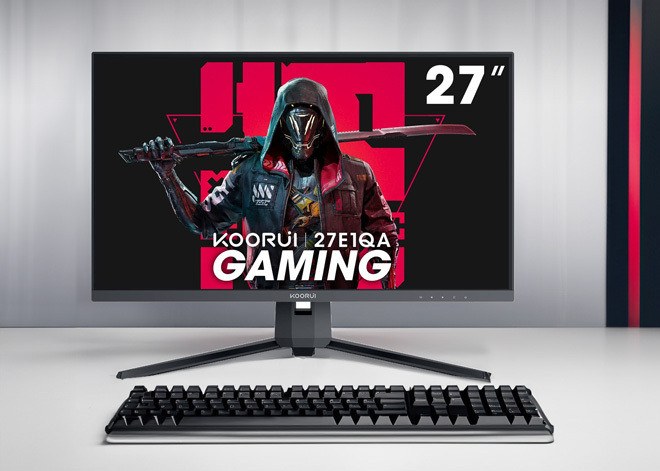A 27-inch WQHD display for less than $200 that is suitable for gaming? My review of Koorui 27E1QA
Recently, I retired my old computer. For 7 years, it had bravely held its own, with only the graphics card being modestly upgraded–and its age gradually starting to show. With the new system, my attention turned to my equally aged monitor. Not only was it unable to display the higher resolutions my new graphics card could display, it also couldn’t handle more than 60 Hz–and had a dead pixel that had been annoying me for quite some time. So, I started looking for a value-oriented replacement and came across the KOORUI 27-inch QHD gaming monitor. Wait a second, QHD resolution, 1 ms response time, and 144 Hz for under $200? It was worth a try–and I got to explain a few technical terms along the way!

What is WQHD and what are its advantages?
First, some basics: WQHD, also known simply as QHD, refers to a screen resolution that has developed over the years as a fine compromise between the somewhat dated Full HD (1920 x 1080 pixels) and the copious 4K (3840 x 2160 pixels). The reason not everyone immediately switched to 4K, or even 8K, has something to do with costs. While 4K screens are already expensive, the hardware needed to power them can be even more expensive. After all, every pixel must be computed by the graphics card (GPU), which can be very resource-intensive, especially with games. Here's how the number of pixels increases with higher resolutions:
HD (1280 x 720): 921,600 pixels
Full HD (1920 x 1080): 2,073,600 pixels
WQHD (2560 x 1440): 3,686,400 pixels
4K (3840 x 2160): 8,294,400 pixels
As you can see, GPUs need to calculate more than twice as many pixels for 4K as for WQHD–and they have to do it multiple times per second. That's because we expect movement to appear smooth, not like going through a flip book. "Smooth" requires a minimum of 24 frames per second (fps), which is the default frame rate for most movies on the big screen. However, 24 fps doesn't look particularly great on home displays, especially with fast games. Most gamers expect at least 60 fps, or significantly more. To support these frame rates at 4K, you need a real beast of a graphics card and would likely have to pay a ridiculous amount of money just for that. For instance, an NVIDIA GeForce RTX 4080 currently sits at around $1200, not exactly a steal.
But if you wanted similar frame rates at WQHD resolution, you would likely go for an NVIDIA GeForce RTX 4070, priced around $550, or a slightly cheaper AMD Radeon RX 7800 XT (~$500)–still a substantial investment, but not even half the price of the 4K alternative. RAM and processor specs also need to be correspondingly beefy for an immersive 4K experience. You can see where this is going: WQHD is a good compromise, offering super crisp visuals on smaller displays and still a good enough pixel density on larger 27-inch screens. If you place WQHD and Full HD displays side by side, you'll instantly notice the additional screen estate and the significantly improved readability. Given that WQHD monitors are only moderately more expensive than Full HD devices, the purchase decision a no-brainer for many.
Back to the Koorui display. What do you really get for less than $200? Honestly, I had never heard of Koorui prior to this review. They are a relatively new entrant into the display market, backed by a Chinese semiconductor giant, with product ratings ranging from euphoria to criticism from real display experts. As I am neither a cheerful influencer nor a detail-obsessed hardware expert with high-end demands, I prefer to form my own opinion. Nothing particularly spectacular struck me during unboxing. Nothing appeared cheap either. There are no sharp edges, and all connections are solidly built. The stand is quickly assembled and firmly connects to the display through a snap mechanism. It fits perfectly! Though the display arm certainly isn't meant for pull-ups, the connection is sturdy and there's no wobble to speak of. There's one DisplayPort and two HDMI ports on the back, plus an audio jack, as the display comes without dedicated speakers. Considering how 90% of built-in speakers sound (lame and pathetic), I don't miss them one bit. Once fully assembled, I was surprised by the product's thin bezel and elegant simple design (you could park a car in the bezels of its predecessor, so no contest, really).

Enough about design. This is a review article, not an art critique. What can this monitor actually do? The initial start-up is promising: My Windows, running in dark mode, boots up with newly found sharpness. With mild euphoria, I launch "The Black 4K Test", a video dreaded by display manufacturers. And lo and behold, the image appears uniformly deep black, no hints of background bleeding, and the colors that follow are crisp. It's a terrific out-of-the-box experience. As I am searching for the physical buttons to play with the settings, I experience my first disappointment: The buttons are located at the bottom edge, slightly set back and recessed. It's like learning to play the accordion blindfolded. Additionally, the menu navigation (especially from my point of view as a software manufacturer) is simply horrifying. It's somewhat usable, and it gets the job done, but it is annoyingly implemented nonetheless. I decide to increase the sharpness by one, everything else already looks great to me. My half-finished blog article is now super legible and my virtual magazine stand Readly looks much better than it ever did in Full HD. I almost forget to register the monitor with Windows as it is still running at the default 60 Hz. After all, the display supports much higher refresh rates up to 144 Hz.
144 Hz means the monitor displays a new image 144 times a second. 60 Hz has been the default for many years, and, in an office setting or when you're watching YouTube videos (which are limited to 60 fps), 60 Hz is fine. At 144 Hz, the mouse pointer will appear to "jump" less and windows, and window contents, will move more smoothly. That's about all that's noticeable during normal use. However, gaming is a different story. Let's say I'm playing a racing game and my graphics card is powerful enough to output 120 frames per second. On a 60 Hz display, I will only see half of these because the monitor can't display more than every other frame. With a 144 Hz monitor, on the other hand, I can see all of them. Animations will look smoother and motion blur will be reduced. To test this, I ran a few games (no fun intended, just work, of course).
My beloved Assassin's Creed Origins shined in all its glory as it took me back to the times of Cleopatra. Whether it's the Nile landscape or the massive palaces, I had never seen the game look so colorful and crystal clear. As I made a few quick turns, all contours were cleanly visible. Red Dead Redemption 2, with its Western aesthetics, appeared even more immersive and exuded a real cinema feel. Even with The Witcher 3 Wild Hunt, an older title, the new display made a significant difference. Movement seemed smoother and the fictional city of Novigrad had never looked better. So, was everything perfect? Almost, because there was still the good old genre of first-person shooter games (also FPS, not to be confused with fps, aka frames per second). As I raced through a few dimly shaded corridors in Doom Eternal, I was annoyed by so-called ghosting that accompanied my quick turns. These "ghosts" are visual artifacts cased by pixels that react too slowly to my movement. It's a common issue with many budget-friendly displays, and Koorui are aware of it. They offer a few mitigating options in the settings (called response time and MPRT), that only provide minor relief, alas.
 Speeding through the pitch-black Gotham? Beware of ghosting!
Speeding through the pitch-black Gotham? Beware of ghosting!
If you spend most of your leisure time racing through dark catacombs, shooting wildly, or engaging in intense online player-vs-player matches, you will want to spend a little more and get a different monitor. Games with brighter visuals and clearer contours, like Cyperpunk 2077, or slower movement will work just fine. Overall, compared to the Dell flagship models I use at work, there is a noticeable difference. With the Dells, colors look a bit more natural and everything somehow seems brighter. However, these displays cost more, are limited to 60 Hz, and have slower response times, making them more suitable for work and internet use.
My conclusion is therefore as follows: With the Koorui 27E1QA, you get a lot of bang for your buck. Colors, size, and performance feel just right. Most games look like paintings and it goes without saying that the device is great for office work and browsing. There's room for improvement as far as the physical buttons are concerned, and the aforementioned ghosting prevalent in dimly lit fast-paced scenes is annoying. Still, those who do not favor this particular content will have a lot of fun with the product. As always, pricing must factor into your expectations and, while there are certainly better products in this device category, they also cost significantly more. In the States, this particular model has occasionally been selling for as low as $150. So, if you're interested, watch out for special deals. As for me, even though I had originally ordered the product for review purposes alone, I'll hold on to it!
P.S. I did not receive a single cent from Koorui for this review. I paid for the monitor myself and our companies are in no way affiliated. I was simply interested, and perhaps you are too!




